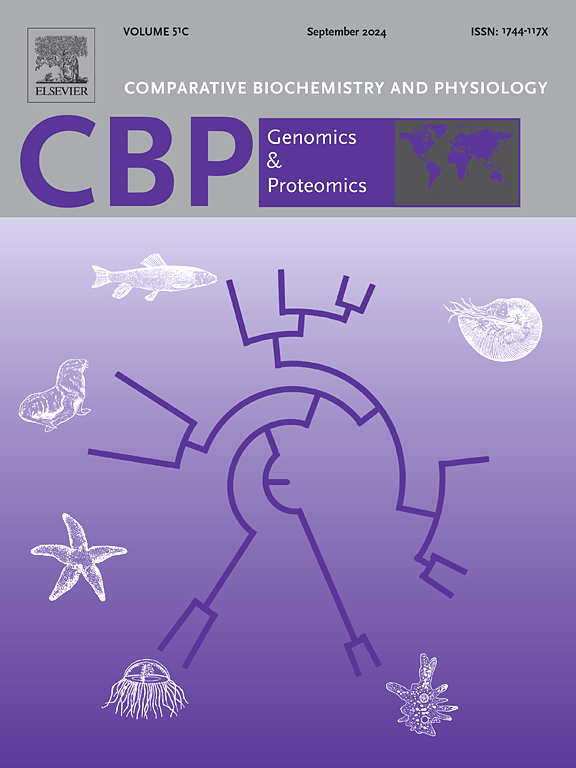铅暴露后小蝌蚪肠道微生物群落变化的宏基因组学研究
IF 2.2
2区 生物学
Q4 BIOCHEMISTRY & MOLECULAR BIOLOGY
Comparative Biochemistry and Physiology D-Genomics & Proteomics
Pub Date : 2025-04-24
DOI:10.1016/j.cbd.2025.101522
引用次数: 0
摘要
铅(Pb)是水生环境中普遍存在的重金属污染物,对水生动物肠道微生物群功能有着复杂的影响。本研究对大蟾蜍蝌蚪进行了铅暴露后的宏基因组分析。此外,对肠道进行组织学分析。结果表明,铅暴露可引起大鼠肠上皮组织损伤。200 μg/L Pb组与对照组相比,微生物丰度和功能有显著差异。具体来说,在200 μg/L Pb时,Bosea和Klebsiella的含量增加,这可能会引起蝌蚪的炎症。值得注意的是,暴露于200 μg/L铅后,糖苷水解酶丰度的下降可能会减弱碳水化合物代谢。此外,暴露于200 μg/L Pb后,氟喹诺酮类相关抗生素耐药基因(ARGs)、酚类相关ARGs和铁摄取系统的增加可能会增加蝌蚪的疾病风险。这些发现增强了我们对铅对两栖动物肠道健康影响的理解,并为进一步评估铅对两栖动物的生态风险提供了有价值的见解。本文章由计算机程序翻译,如有差异,请以英文原文为准。

Metagenomic insights into the alterations of gut microbial community in Bufo gargarizans tadpoles following lead exposure
Lead (Pb), a prevalent heavy metal contaminant in aquatic environments, has complex effects on the gut microbiome function of aquatic animals. In this study, metagenomic analysis of Bufo gargarizans tadpoles was carried out following Pb exposure. Moreover, histological analysis was performed on the intestines. The results showed that Pb exposure induced histological damage to the intestinal epithelium. Significant differences in microbial abundance and function were detected in the 200 μg/L Pb group compared to the control group. Specifically, an increase in Bosea and Klebsiella was noted at 200 μg/L Pb, which potentially could induce inflammation in tadpoles. Notably, the decrease in the abundance of glycoside hydrolases subsequent to exposure to 200 μg/L Pb is likely to attenuate carbohydrate metabolism. Furthermore, increased fluoroquinolone-related antibiotic resistance genes (ARGs), phenolic-related ARGs, and iron uptake systems following 200 μg/L Pb exposure might heighten the disease risk for tadpoles. These discoveries augment our comprehension of the influences of Pb on the intestinal well-being of amphibians and offer valuable insights for further assessment of the ecological risks that Pb poses to amphibians.
求助全文
通过发布文献求助,成功后即可免费获取论文全文。
去求助
来源期刊
CiteScore
5.10
自引率
3.30%
发文量
69
审稿时长
33 days
期刊介绍:
Comparative Biochemistry & Physiology (CBP) publishes papers in comparative, environmental and evolutionary physiology.
Part D: Genomics and Proteomics (CBPD), focuses on “omics” approaches to physiology, including comparative and functional genomics, metagenomics, transcriptomics, proteomics, metabolomics, and lipidomics. Most studies employ “omics” and/or system biology to test specific hypotheses about molecular and biochemical mechanisms underlying physiological responses to the environment. We encourage papers that address fundamental questions in comparative physiology and biochemistry rather than studies with a focus that is purely technical, methodological or descriptive in nature.

 求助内容:
求助内容: 应助结果提醒方式:
应助结果提醒方式:


